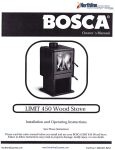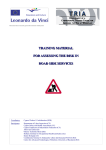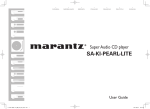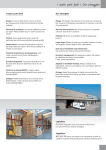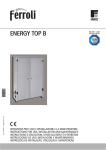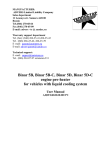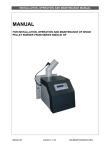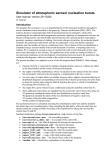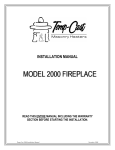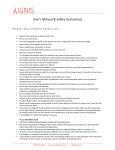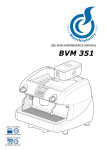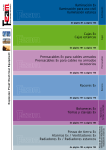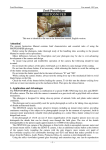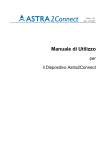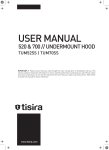Download Fireplace-Stove Umega-5
Transcript
EN Technical certificate, instruction for installation and use Umega-5(14.05) V1 EN Fireplace-Stove Umega-5 EN 13240 UMEGA - 5 UMEGA - 5 To General Manager of AB “Umega” Application for warranty service I ........................................................................., have bought a product made by your company (name, surname or company name) product......................................................, serial No. ..................., ............................................ (product name) (date of manufacture) ………………………………………………………………………………………………….............. (date of purchase, place, name of a purchase document and number) After having read the user's manual and product's technical datasheet, I hereby declare that the product is installed in compliance with requirements set in the technical datasheet and is being used in a way it is intended for and in compliance with requirements set in the user's manual. Taking into consideration the foregoing, I have a claim in respect of this product: …………………….…………………….………………………………………..…………............…. ………………………………………………………………………………………………….............. ………………………………………………………………………………………………….............. ………………………………………………………………………………………………….............. ……………………………………………………………………………………………….…............. …………………………………………………………………………………………….…................. …………………………………………………………………………………………….…….............. …………………………………………………………………………………………….…….............. …………………………………………………………………………………………….…….............. …………………………………………………………………………………………….…….............. I believe that defects listed in the claim occurred due to imperfection of your product and hereby ask you to send your representatives in order to inspect the connected product, to identify the defects and to rectify them. Should there be determined that the abovementioned defects were caused by improper connection or misuse of the product, or should there be determined that there are no warranty defects, I undertake to reimburse transportation expenses of your representatives (0.8 € / km) and pay for the time spent in the trip and place of inspection (30 € / h) to each service team member (not more than three employees). I agree that the above-mentioned expenses were recovered from me in accordance with the legislation of LR, provided that I do not reimburse them within 7 calendar days. TABLE OF CONTENTS 1. Shared data..........................................................................4 2. Technical specifications ..................................................... 5 3. Design description ............................................................ 6 4. Installation ......................................................................... 7 4.1. Place of installation ......................................... 7 4.2. Requirements for flue and chimney .................. 8 4.3. Connection of flue from the top ....................... 8 5. Use .................................................................................... 8 5.1. First heating ..................................................... 9 5.2. Heating ............................................................ 9 5.3. Ash cleaning ................................................... 9 5.4. Fuel .................................................................. 9 6. Technical safety requirements .......................................... 10 7. Maintenance...................................................................... 10 7.1. Glass cleaning ................................................. 10 7.2. Interior and exterior cleaning............................ 10 7.3. Replacement parts .......................................... 10 8. Troubleshooting................................................................. 11 9. Transportation and storage................................................. 11 10. Package contents............................................................. 12 11. Warranty .......................................................................... 12 12. Acceptance certificate....................................................... 13 13. Application for warranty service..........................................14 My address…………………………………...............…………., telephone ……………………. ………………………………………………………………. ………………………….. Name, surname 14 Signature UMEGA-5 (14.05) V1 EN UMEGA-5 (14.05) V1 EN 3 UMEGA - 5 UMEGA - 5 Dear Buyer! Acceptance certificate Thank You for purchasing our company’s article and for the confidence in products of JSC “UMEGA”. We wish you success in use of it! JSC “UMEGA” Type of a fireplace Serial No 1.Shared data _________________________ Complies with the requirements of LST EN 13240 and ГОСТ 9817-95 and is suitable for use The stove “Umega 5” is designed for heating residential and public areas. This stove contains a modern construction and ensures long term usage while using it properly. The Stove “Umega 5” conforms LST EN 13240:2002 standard and Austrian document "Art.15a BVG Vereinbarung über das Inverkehrbringen von Kleinfeuerungen und die Überprüfung von Feuerungsanlagen und Blockheizkraftwerken" requirements. Stove “Umega 1” conforms highest environment, economic and manufacturing requirements. More technical information about the stove, you can find: www.umega.lt Date of manufacture NOTICE! Before installation and operation of the Fireplace-Stove, please read this manual. This will help You to properly install and the most effectively use the product purchased and to avoid accidents. When buying the boiler, please read terms of warranty, make sure that the certificate of acceptance is filled in completely and correctly. UMEGA-5 (14.05) V1 EN Filled in by seller Completed by 4 UMEGA - 5 _________________________ _________________________ __________________________________________ Date of sale, signature UMEGA-5 (14.05) V1 EN 13 UMEGA - 5 UMEGA - 5 10. Package contents Fireplace Glove Technical datasheet Wooden pallet 2. Technical specifications 1 pc. 1 pc. 1 pc. 1 pc. Pavadinimas 11. Warranty Manufacturer guarantees that the fireplace complies with the requirements of LST EN 13240 and ГОСТ 9817-95, provided that transportation, storage, installation and operation requirements were obeyed. The fireplace is covered by a 24 month warranty; the beginning of the warranty period starts on the day of purchase. For firegrate 6 month warranty. At the time of sale a salesman must inform a customer about the warranty terms and conditions, to fill in acceptance certificate and to deliver a technical datasheet. During the warranty period manufacturer is obliged to rectify any defects free of charge, provided that they were not caused by manufacturer's fault. Warranty shall not apply in the following cases: no purchase documents (a VAT invoice, a cashier's check or a cash order) are presented; no acceptance certificate is presented; the acceptance certificate is not completed or is completed wrong (the date of sale is not indicated, the shop stamp is not present, there is no serial number of the fireplace or the serial number does not match with the serial number indicated on the data plate on the side of the fireplace); fuel); - installation and operation requirements are violated; there is mechanical damage of the fireplace; it has been determined that the fireplace was overheated (e.g., by using a wrong type of it has been determined that the fireplace was repaired by unauthorized person; acts of God; the warranty does not apply to door glass and vermiculite plates. Fuel used * Maximum recommended measurements of firewood Efficiency at nominal power Nominal thermal power when heating with firewood Diameter of flue connection Chimney draught at nominal power Average temperature of combustion products Combustion gas flow Volume of heated premises Burning time of the fuel load at nominal power* Fuel consumption Measurements : height width depth Weight, no more than Units mm % kW mm Pa 0 C g/s UMEGA-5 Firewood Ø300 x 60 x 70 80 7 Ø150 12 300 5,7 m3 h kg/h 70 mm mm 1000 604 490 114 mm kg 2 2 *the time it takes for one load of fuel to burn completely depends on the type of fuel, humidity, amount of fuel in one load, and other factors. The fireplace is designed for intermittent operation i.e. normally a new load of fuel is loaded after the previous one has burned completely. The fireplace must be used only with the door closed. I have read and understand the warranty terms and conditions: ________________________________________ Surname of the customer, signature, and date In case you run into any trouble during installation or use of the fireplace, please call +370 687 95628; +370 340 60532; +370 340 60530. In case you have any claims regarding quality of the product, please fill in an application for warranty service and send it together with a copy of a purchase document by registered mail to the manufacturer: AB “Umega” dpt. “Vienybe”, Kauno str. 120, LT-20115, Ukmerge. In case of an emergency please call the above-mentioned numbers or send an application for warranty service by fax +370 340 63544 or email [email protected], and hand in the filled in and signed application and purchase document to company employees upon their arrival. 12 UMEGA-5 (14.05) V1 EN UMEGA-5 (14.05) V1 EN 5 UMEGA - 5 UMEGA - 5 8. Troubleshooting 3.Design description. ATTENTION! A construction of the fireplace is subject to continuous development; therefore minor deviations from this manual are possible. The design of the fireplace shall not be modified without our consent. The stove has a double case design which makes the use of an item safe and convenient. Air is sucked in at the bottom of the case, moves upwards and is released through the holes at the top and sides of the stove when it is hot. Air goes though the holes, which are in the back side (12), and makes combustion conditions better. The case of the fireplace is welded from sheets of metal and painted with heat-resistant paint. Surface of the combustion is lined with heat resistant plates (vermiculite) 3 (See 1 pic.) that facilitate combustion. Door of the fireplace (7) has a small window made of heat resistant glass (1), that allows watching the flame. Supply of initial air is controlled with the help of valve 5. The valve is open when it is completely shifted towards the front of the fireplace and it is closed when it is completely shifted away from the front of the fireplace. The secondary air is supplied into the combustion chamber through control valve 6. The valve is completely opened when it is in the right side position and it is completely closed when it is in left side position, when looking from the front of the fireplace. Problem Cause Smoke enters room during use of the fireplace Insufficient chimney draught Chimney is too low Diameter of chimney is too small Firewood is too damp Insufficient air supply into the room Fire in the fireplace dies out Unusually high amount of soot on the glass Air supply valve closed Flue is blocked by soot Too much ash in an ash bin Use firewood with up to 20% humidity Make sure air supply is sufficient, e.g. install an air vent; turn off cooker hood. Open air supply valve. Clean the flue. Remove ashes. Use firewood with up to 20% humidity Large non-split firewood is being used. Use split firewood of recommended size Wrong type of fuel is being used (e.g. resin, plastic, wood waste etc.) Use only recommended type of fuel Wrong orientation of firewood. Stack firewood parallel to glass Fireplace overheats Too much fuel and air supply valve open Extremely dry firewood (e.g. old Loose door glass Install a chimney of proper height and diameter Firewood is too damp Wrong type of fuel being used (e.g. coal) Fire in the chimney Corrective actions Soot accumulated inside the chimney, and the chimney has not been cleaned for a long time Glass mounting screw is loose Extinguish fire: remove the fuel and throw it into container with water. The room must be ventilated. Do not attempt to extinguish fire by pouring water into the combustion chamber; this may cause irreparable damage to the fireplace. Use only recommended type of fuel Close air supply valves, close smoke valve and call fire brigade. With the help of a screwdriver, tighten glass mounting screws; do not over-tighten, this may cause cracks in glass. 9. Transportation and storage 1 pic. 1. Heat resistant glass; 2. Cast iron fire grate; 3. Vermiculite plates; 4. Ash bin; 5. Initial air supply valve; 6. Secondary air supply valve; 7. Door; 8. Top; 9. Flue connection; 10.Cover; 11. Safety shield; 12. Back plate 6 UMEGA-5 (14.05) V1 EN Fireplaces may be transported by any means of transport only in an upright position. During transportation it is necessary to protect fireplaces against rainfall or snow. Fireplaces must be securely fastened to protect against overturning or scratches due to touching surfaces during transportation. Loading and unloading must be executed with due care in order to protect fireplaces against breaking. Fireplaces must be stored in a dry place. It shall not be stored together with any chemicals capable of reaction with metals. Do not stack fireplaces during transportation or storage.Fireplaces should be transported and stored only in original package secured on a wooden pallet and covered with polyethylene film - unless otherwise discussed in a supply agreement. UMEGA-5 (14.05) V1 EN 11 UMEGA - 5 UMEGA - 5 6. Technical safety requirements During use of a fireplace, it is prohibited to: - use highly flammable liquids (petrol, kerosene, acetone etc.) to start a fire in the fireplace; - keep the doors open when the fire is on; - leave the fireplace to be supervised by young children; - keep flammable items on the fireplace; - use fireplace without an ash bin; - stoke with a barrier removed; - leave burning fireplace unattended; 4. Installation The fireplace shall be installed in premises that meet construction standards and requirements. Installation and connection of the fireplace to a chimney shall be performed in accordance with "Rules for installation of hard fuel stoves in buildings" ST 8860237.02:1998. Whilst installing the fireplace it is necessary to comply with local regulations, including any references to local and European standards. The fireplace shall be installed by a qualified specialist or a person that has experience of such work. The fireplace shall be installed in such a way that air supply and control valves 5 and 6 are not blocked in any way (see 1 pic.). It is necessary to periodically clean the chimney from resins and soot in order to prevent fire hazard. Use metal containers for collection and removal of ashes. Do not pour glowing embers and ash near flammable surfaces. Make sure chimney draught is not too strong and no sparks are being thrown. 4.1. Place of installation The fireplace shall be installed on a fireproof surface that is strong enough to bear the weight of the item. When the fireplace is installed on a non-fireproof floor, at least 1 mm thick metal sheet or any other insulation material must be placed underneath it. Measurements of the sheet must extend through the measurements of the fireplace in the following way: from door 0.5 m, from sides and back 0.1 m. Any combustible covering, such as linoleum or carpeting, under the sheet must be removed. Distance from the door of the fireplace to any combustible wall must be at least 1.25 m; distance from walls and back to any combustible wall must be at least 0.5 m. The fireplace must be installed in a way that there would be enough space for cleaning of the fireplace itself, flue and chimney. It is necessary to supply sufficient amount of fresh air into premises where the fireplace is installed. When the fireplace is used the supply of fresh air should be up to 15 m3 per hour. In case there are any other heating devices installed in the same room, it is necessary to make sure there is sufficient air supply to all heating devices. For this reason a vent hole with protective grating may be installed. It is necessary to make sure the vent hole is not blocked by any foreign objects and that it cannot close itself. 7. Maintenance ATTENTION! Clean the fireplace only when it has completely cooled off. In order to achieve the best and safe use of the fireplace it is recommended to call specialists to perform regular fireplace and chimney inspection 7.1. Glass cleaning During the normal use of the fireplace no soot or other grime should accumulate on the glass. Use dry and soft cloth to clean a slightly dirty glass. Use special non-abrasive glass cleaners to remove stubborn stains. 7.2. Interior and exterior cleaning In order to achieve effective performance of the fireplace, it is necessary to clean interior surfaces and remove any accumulated resins and soot. Use special cleaners for this. You may remove a barrier before cleaning. Exterior surfaces of the fireplace may be vacuum cleaned or use a dry and soft cloth for it. After several years of use paint of the fireplace may exhibit little color change. You may repaint the fireplace in order to renew its color. Special heat-resistant paint is available for purchase from the manufacturer. 7.3. Replacement parts Parts, such as cast iron fire grate, vermiculite plates, sealant cord etc., may burn out or crack during use of the fireplace. Replacement parts may be ordered from the manufacturer. ATTENTION! Use only original or recommended by the manufacturer replacement parts. Use of non-original replacement parts for repairs during the warranty period will void the warranty. 10 UMEGA-5 (14.05) V1 EN UMEGA-5 (14.05) V1 EN 7 UMEGA - 5 UMEGA - 5 4.2. Requirements for flue and chimney Metal pipes used for connection of the fireplace to a chimney must be made of at least 1.5 mm thick metal plate. A chimney, a flue and air-ducts must comply with construction regulations and rules. A diameter of a chimney hole must be at least Ø 150 mm. The fireplace must be connected to a separate chimney; no other devices can be connected to it. Minimum draught of the chimney at nominal power is 10 Pa. In case the chimney draught is too strong, a smoke valve or draught regulator may be installed. It may be installed inside flue or chimney. The minimum recommended height of the chimney is 5 m above the fireplace. The top of the chimney must be above the highest point of a roof. An opening for cleaning must be provided in the chimney. It is recommended to clean the flue before a heating season and every 3 months afterwards. The flue and chimney must be inspected for any blockages if the fireplace was not used for a long period of time. It is recommended to install stainless steel liner inside the chimney to protect it from harmful effects of moisture condensation and smoke exposure. A flue, connecting the fireplace and the chimney, must be as short as possible and must be directed up towards the chimney. The maximum recommended horizontal length of the flue is 1 m. In order to connect a flue to a brick chimney: mark a place where the flue will be connected; using suitable tools make a hole that is slightly bigger than the diameter of the flue; insert the flue. Seal the spaces with fireproof material, e.g., rock wool or glass cord. 4.3. Connection of flue from the top and from the back The fireplace is ready for flue connection form the back. In order to connect a flue from the top: remove the flue connection 10 (see 1 pic.) by unscrewing mounting screws. with the help of a suitable tool remove the screen from the cover (11) of the top of the fireplace; insert the flue connection into the place of the cover and tighten it with screws; insert the cover at the back and tighten in with screws. 5. Use ATTENTION! Maintenance of the fireplace shall be performed only by adults having read this user's manual. During use surfaces of the fireplace become hot; a risk of burns. When opening / closing the door and adjusting the control valves it is necessary to wear protective glove (included). Prior to heating the fireplace, make sure there are no flammable items on it. 5.1. First heating During the first heating of the fireplace it can emit a specific smell and visible vapors, and it may seem that smoke is flowing into a room instead of flowing through the chimney. This should stop after 1 or 2 full and intensive heating cycles. It is necessary to have a good ventilation of the room during the first heating of the fireplace. Later on the fireplace may be heated normally. 5.2. Heating Firing up. Fully open an initial air supply valve 5 by pulling it towards self (see 1 pic.) Fully open a secondary air supply valve by setting it into the right side position (when looking from the front). Put two average size pieces of firewood on the bottom of a combustion chamber; leave a gap between those two pieces. Put some crumpled newspaper or a solid fuel tablet in the gap, then put some shredded and dry firewood in a crosswise manner and then some average size firewood on top. Light up the paper and close the door when the paper starts to burn well. A handle of the door may be hot; therefore a safety glove should be used. Control the intensity of fire with the help of air supply valve Adding fuel. The first load of fuel must burn completely, i.e. only embers must remain in the fireplace, before adding a new load. It is necessary to slightly open the door in order to even out the air pressure before the door is opened fully. This will prevent smoke from entering a room, especially when chimney draught is weak. After adding a new load of fuel it is necessary to close the fireplace door and fully open initial air supply valve for approximately 5 seconds for the fuel to start burning well. After this the valves should be closed leaving only a small gap as during normal heating. In order to prevent fireplace from overheating it is recommended to use 2.5 kg of firewood for one load at most. It is recommended to put the firewood parallel to glass. ATTENTION! When adding firewood into the fireplace make sure it does not touch the glass Heating during adverse weather conditions. In certain cases, e.g. when ambient temperature is above 15oC, the weather is rainy and damp, or when a wind is gusty etc., the chimney draught might be worse than usual. In such cases a minimum amount of fuel should be used in the fireplace and the initial air supply valve should be fully opened. 5.3. Ash cleaning After the fuel has burnt, ashes should be removed from the combustion chamber into an ashbin using a suitable rake. Ashes should be removed only after it has cooled completely. Ashes should be poured into a fire-resistant container. Ashes must be removed at least every second heating; otherwise it can block the air supply. 5.4. Fuel ATTENTION! Only the recommended type of fuel shall be used for heating; use of other type of fuel (e.g. coal) may result in overheating of the fireplace. In such a case the warranty would not be applied.. The fireplace is designed for use with firewood (deciduous trees recommended). Firewood should be cut and split. Humidity of firewood used for heating should not be higher than 20%. Such firewood humidity level is achieved after 1 to 2 year storage of the firewood in a ventilated shelter. Use of damp firewood results in reduced power of a fireplace, increased consumption of fuel; accumulation of resins, cracking of vermiculite plates and faster corrosion of combustion chamber. Due to higher accumulation of resins use of coniferous firewood is not recommended. 8 UMEGA-5 (14.05) V1 EN UMEGA-5 (14.05) V1 EN 9








